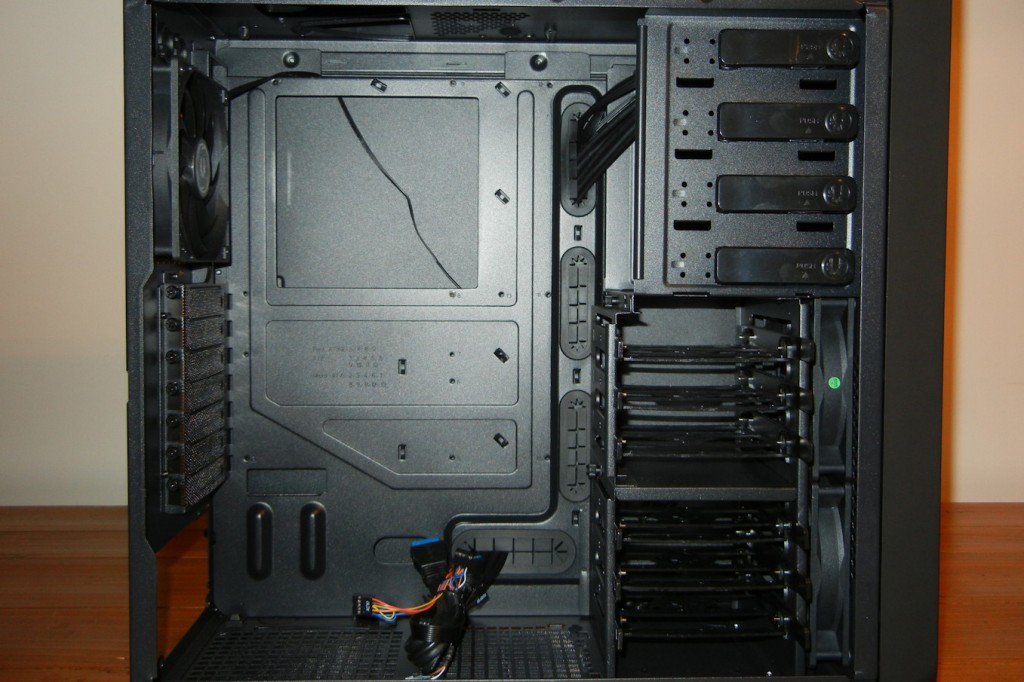INTERIOR
Moving on to the interior, we are presented with a very spacious layout, which looks like it will have no trouble accommodating even the most colossal add-in cards. With video cards apparently becoming longer and longer with every new generation (Nvidias new GTX 680 being a notable exception), the extra wiggle room is much appreciated.
 I always get a nice warm and fuzzy feeling when a cases interior doesnt look as though like it was designed by Smurfs, and believe me, after seeing the insides, all of Smurf Town could be incinerated. A little morbid maybe, but the fact is, the interior of this case gives users a lot of real estate to work with, making the process of installing hardware that much more enjoyable.
I always get a nice warm and fuzzy feeling when a cases interior doesnt look as though like it was designed by Smurfs, and believe me, after seeing the insides, all of Smurf Town could be incinerated. A little morbid maybe, but the fact is, the interior of this case gives users a lot of real estate to work with, making the process of installing hardware that much more enjoyable.
FEATURES
 Another aspect of the interior includes tool less installation of drives and add-in cards. In particular the Raider uses thumb screws to secure add-in cards, though these have been a standard feature of many cases for quite some time now.
Another aspect of the interior includes tool less installation of drives and add-in cards. In particular the Raider uses thumb screws to secure add-in cards, though these have been a standard feature of many cases for quite some time now.
Drive rails are used for the 3.5 internal drives and 2.5 drives can be used as well, although they must be secured with four screws.
This attribute does, however, save users from having to go out of their way to buy a bay adapter for their brand new screamin fast SSD. When one takes tax or shipping costs into consideration, this is one feature which will no doubt pique the interest of many enthusiasts, especially if theyre a regular visitor of this site.
The 5.25 drive bays employ a locking mechanism similar to those seen on a number of other recent designs.
 In my own experience, this type of system can actually be quite effective, though users retain the option of using screws on the opposite side to ensure everything is as secure as possible; this may be a wise idea for those who attend lan parties on a regular basis.
In my own experience, this type of system can actually be quite effective, though users retain the option of using screws on the opposite side to ensure everything is as secure as possible; this may be a wise idea for those who attend lan parties on a regular basis.
The Raider also includes the necessary cabling for things like the aforementioned USB ports, as well as front panel audio, power and reset switches, HDD and power LEDs.

 This rear 120mm fan serves as the sole means (not including the power supply) of exhaust for the entire case. It should be more than enough in most cases, however, those considering engaging in overclocking to any meaningful extent will definitely want to step up to something with a little more CFM. For the purposes of this review, I will be replacing the rear exhaust with an Antec Kuhler 920 water cooler, which should provide more than enough oomph for some moderate to heavy OCing and improve overall airflow as well.
This rear 120mm fan serves as the sole means (not including the power supply) of exhaust for the entire case. It should be more than enough in most cases, however, those considering engaging in overclocking to any meaningful extent will definitely want to step up to something with a little more CFM. For the purposes of this review, I will be replacing the rear exhaust with an Antec Kuhler 920 water cooler, which should provide more than enough oomph for some moderate to heavy OCing and improve overall airflow as well.
 The SSD Review The Worlds Dedicated SSD Education and Review Resource |
The SSD Review The Worlds Dedicated SSD Education and Review Resource | 